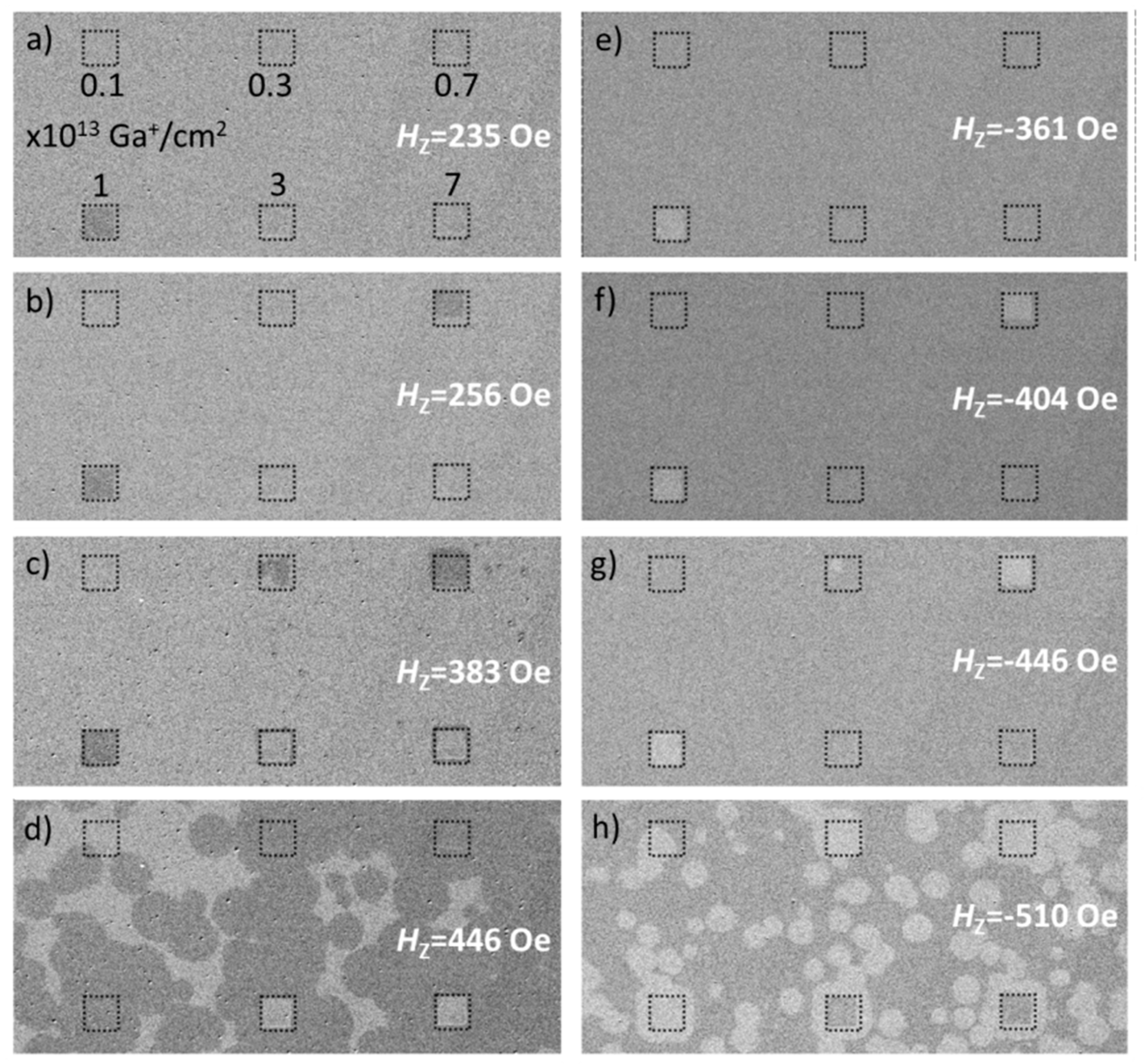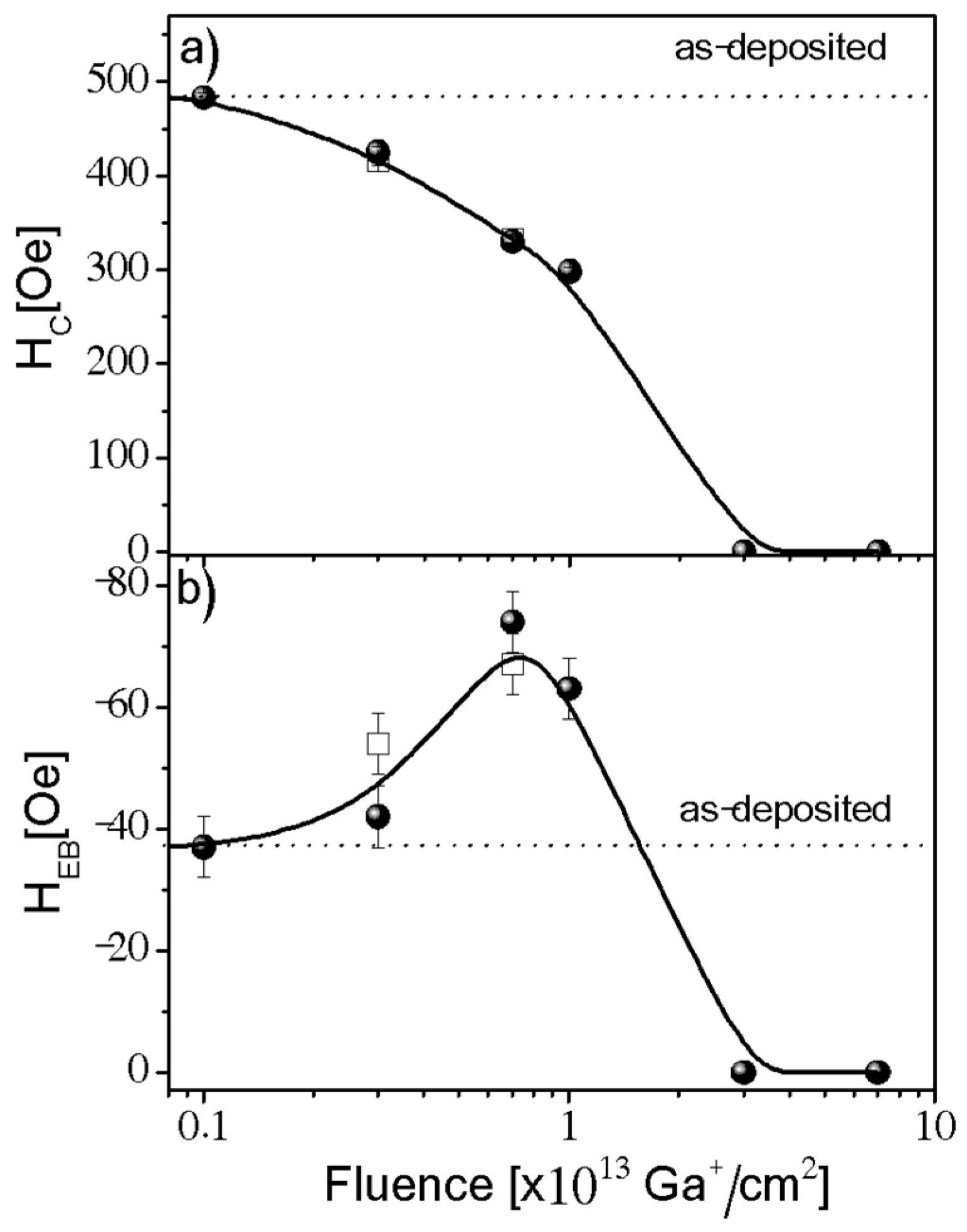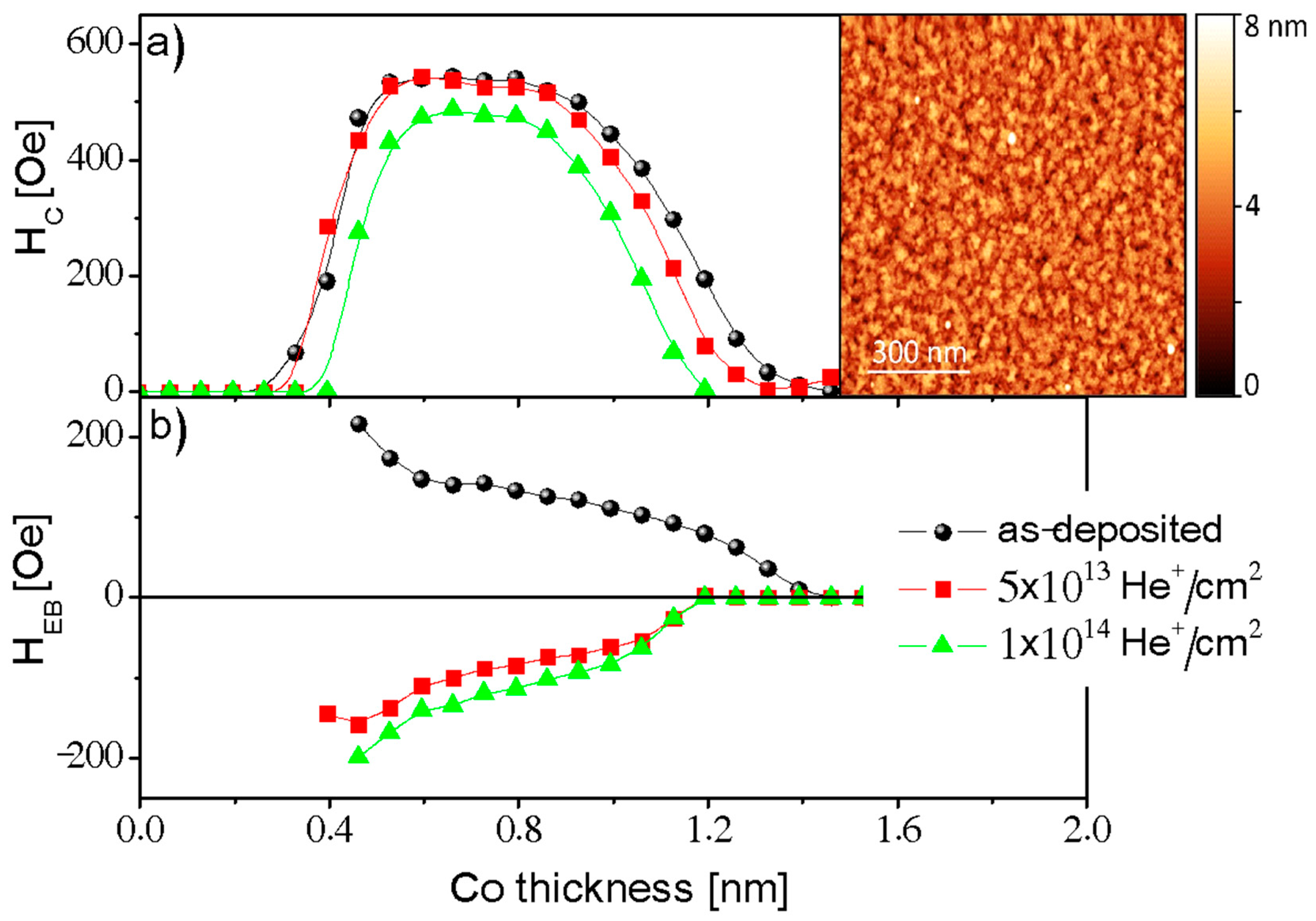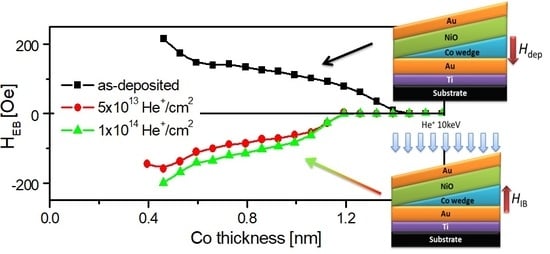Tailoring Perpendicular Exchange Bias Coupling in Au/Co/NiO Systems by Ion Bombardment
Abstract
:1. Introduction
2. Materials and Methods
3. Results
4. Discussion
5. Conclusions
Author Contributions
Funding
Conflicts of Interest
References
- Nogués, J.; Sort, J.; Langlais, V.; Skumryev, V.; Suriñach, S.; Muñoz, J.S.; Baró, M.D. Exchange bias in nanostructures. Phys. Rep. 2005, 422, 65–117. [Google Scholar] [CrossRef]
- Młyńczak, E.; Gurgul, J.; Przewoźnik, J.; Wilgocka- Ślęzak, D.; Freindl, K.; Spiridis, N.; Korecki, J. Effect of interfacial iron oxidation on the exchange bias in CoO/Fe bilayers. Appl. Surf. Sci. 2014, 304, 86–90. [Google Scholar] [CrossRef]
- Chang, C.-H.-T.; Chang, S.-C.; Tsay, J.-S.; Yao, Y.-D. Enhanced exchange bias fields for CoO/Co bilayers: Influence of antiferromagnetic grains and mechanisms. Appl. Surf. Sci. 2017, 405, 316–320. [Google Scholar] [CrossRef]
- Gurgul, J.; Młyńczak, E.; Kozioł-Rachwał, A.; Matlak, K.; Freindl, K.; Madej, E.; Spiridis, N.; Ślęzak, T.; Korecki, J. Magnetic properties of epitaxial CoO/Fe(001) bilayers: The onset of exchange bias as a function of sublayer thickness and temperature. Phys. Rev. B 2017, 96. [Google Scholar] [CrossRef]
- Maat, S.; Takano, K.; Parkin, S.S.P.; Fullerton, E.E. Perpendicular exchange bias of Co/Pt multilayers. Phys. Rev. Lett. 2001, 87, 087202. [Google Scholar] [CrossRef] [PubMed]
- Lamirand, A.D.; Soares, M.M.; Ramos, A.Y.; Tolentino, H.C.N.; De Santis, M.; Cezar, J.C.; de Siervo, A.; Jamet, M. Robust perpendicular exchange coupling in an ultrathin CoO/PtFe double layer: Strain and spin orientation. Phys. Rev. B 2013, 88. [Google Scholar] [CrossRef] [Green Version]
- Radu, F.; Zabel, H. Exchange bias effect of ferro-/antiferromagnetic heterostructures. In Magnetic Heterostructures, Advances and Perspectives in Spinstructures and Spintransport; Zabel, H., Bader, S.D., Eds.; Springer: Berlin/Heidelberg, Germany, 2008; pp. 97–184. [Google Scholar]
- Rickart, M.; Guedes, A.; Franco, N.; Barradas, N.P.; Diaz, P.; MacKenzie, M.; Chapman, J.N.; Freitas, P.P. Exchange bias in ordered antiferromagnets by rapid thermal anneal without magnetic field. J. Phys. Appl. Phys. 2005, 38, 2151–2155. [Google Scholar] [CrossRef]
- Engel, D.; Ehresmann, A.; Schmalhorst, J.; Sacher, M.; Höink, V.; Reiss, G. Initialization of unidirectional anisotropy in a ferromagnet–antiferromagnet bilayer by keV-He ion bombardment. J. Magn. Magn. Mater. 2005, 293, 849–853. [Google Scholar] [CrossRef]
- Ehresmann, A.; Junk, D.; Engel, D.; Paetzold, A.; Röll, K. On the origin of ion bombardment induced exchange bias modifications in polycrystalline layers. J. Phys. Appl. Phys. 2005, 38, 801–806. [Google Scholar] [CrossRef]
- Mougin, A.; Mewes, T.; Jung, M.; Engel, D.; Ehresmann, A.; Schmoranzer, H.; Fassbender, J.; Hillebrands, B. Local manipulation and reversal of the exchange bias field by ion irradiation in FeNi/FeMn double layers. Phys. Rev. B 2001, 63, 060409. [Google Scholar] [CrossRef]
- Ehresmann, A.; Engel, D.; Weis, T.; Schindler, A.; Junk, D.; Schmalhorst, J.; Höink, V.; Sacher, M.D.; Reiss, G. Fundamentals for magnetic patterning by ion bombardment of exchange bias layer systems. Phys. Status Solidi B 2006, 243, 29–36. [Google Scholar] [CrossRef]
- Mougin, A.; Poppe, S.; Fassbender, J.; Hillebrands, B.; Faini, G.; Ebels, U.; Jung, M.; Engel, D.; Ehresmann, A.; Schmoranzer, H. Magnetic micropatterning of FeNi/FeMn exchange bias bilayers by ion irradiation. J. Appl. Phys. 2001, 89, 6606–6608. [Google Scholar] [CrossRef]
- Mewes, T.; Lopusnik, R.; Fassbender, J.; Hillebrands, B.; Jung, M.; Engel, D.; Ehresmann, A.; Schmoranzer, H. Suppression of exchange bias by ion irradiation. Appl. Phys. Lett. 2000, 76, 1057–1059. [Google Scholar] [CrossRef]
- Mazalski, P.; Kurant, Z.; Maziewski, A.; Liedke, M.O.; Fassbender, J.; Baczewski, L.T.; Wawro, A. Ion irradiation induced enhancement of out-of-plane magnetic anisotropy in ultrathin Co films. J. Appl. Phys. 2013, 113, 17C109. [Google Scholar] [CrossRef]
- Sakamaki, M.; Amemiya, K.; Liedke, M.O.; Fassbender, J.; Mazalski, P.; Sveklo, I.; Maziewski, A. Perpendicular magnetic anisotropy in a Pt/Co/Pt ultrathin film arising from a lattice distortion induced by ion irradiation. Phys. Rev. B 2012, 86, 024418. [Google Scholar] [CrossRef]
- Chappert, C.; Bernas, H.; Ferre, J.; Kottler, V.; Jamet, J.-P.; Chen, Y.; Cambril, E.; Devolder, T.; Rousseaux, F.; Mathet, V.; et al. Planar patterned magnetic media obtained by ion irradiation. Science 1998, 280, 1919–1922. [Google Scholar] [CrossRef] [PubMed]
- Fassbender, J.; McCord, J. Magnetic patterning by means of ion irradiation and implantation. J. Magn. Magn. Mater. 2008, 320, 579–596. [Google Scholar] [CrossRef]
- Kuświk, P.; Ehresmann, A.; Tekielak, M.; Szymański, B.; Sveklo, I.; Mazalski, P.; Engel, D.; Kisielewski, J.; Lengemann, D.; Urbaniak, M.; et al. Colloidal domain lithography for regularly arranged artificial magnetic out-of-plane monodomains in Au/Co/Au layers. Nanotechnology 2011, 22, 095302. [Google Scholar] [CrossRef] [PubMed]
- Chambers, S.A. Epitaxial growth and properties of thin film oxides. Surf. Sci. Rep. 2000, 39, 105. [Google Scholar] [CrossRef]
- Kuświk, P.; Matczak, M.; Kowacz, M.; Szuba-Jabłoński, K.; Michalak, N.; Szymański, B.; Ehresmann, A.; Stobiecki, F. Asymmetric domain wall propagation caused by interfacial Dzyaloshinskii-Moriya interaction in exchange biased Au/Co/NiO layered system. Phys. Rev. B 2018, 97. [Google Scholar] [CrossRef]
- Lengemann, D.; Engel, D.; Ehresmann, A. Plasma ion source for in situ ion bombardment in a soft x-ray magnetic scattering diffractometer. Rev. Sci. Instrum. 2012, 83, 053303. [Google Scholar] [CrossRef] [PubMed]
- Rettner, C.T.; Anders, S.; Baglin, J.E.E.; Thomson, T.; Terris, B.D. Characterization of the magnetic modification of Co/Pt multilayer films by He+, Ar+, and Ga+ ion irradiation. Appl. Phys. Lett. 2002, 80, 279–281. [Google Scholar] [CrossRef]
- Kuświk, P.; Szymański, B.; Urbaniak, M.; Dubowik, J.; Stobiecki, F.; Kisielewski, J.; Tekielak, M.; Maziewski, A.; Weis, T.; Ehresmann, A. He+ ion bombardment induced effects on magnetic properties of Ni-Fe/Au/Co/Au films. Acta Phys. Pol. A 2008, 113, 651–656. [Google Scholar] [CrossRef]
- Kuświk, P.; Stobiecki, F.; Szymański, B.; Urbaniak, M.; Falkowski, M.; Jagielski, J.; Mazalski, P. Effect of He ions irradiation on anisotropy and magnetoresistance of (NiFe/Au/Co/Au)10 multilayers. Nucl. Instrum. Methods Phys. Res. Sect. B Beam Interact. Mater. At. 2012, 272, 88–91. [Google Scholar] [CrossRef]
- Ehresmann, A.; Schmidt, C.; Weis, T.; Engel, D. Thermal exchange bias field drift in field cooled Mn83Ir17/Co70Fe30 thin films after 10 keV He ion bombardment. J. Appl. Phys. 2011, 109, 023910. [Google Scholar] [CrossRef]
- Engel, D.; Kronenberger, A.; Jung, M.; Schmoranzer, H.; Ehresmann, A.; Paetzold, A.; Röll, K. Exchange anisotropy modification in NiO/NiFe bilayers by ion bombardment. J. Magn. Magn. Mater. 2003, 263, 275–281. [Google Scholar] [CrossRef]
- Juraszek, J.; Fassbender, J.; Poppe, S.; Mewes, T.; Hillebrands, B.; Engel, D.; Kronenberger, A.; Ehresmann, A.; Schmoranzer, H. Tuning exchange bias and coercive fields in ferromagnet/antiferromagnet bilayers with ion irradiation. J. Appl. Phys. 2002, 91, 6896. [Google Scholar] [CrossRef]
- Fulcomer, E.; Charap, S.H. Thermal fluctuation aftereffect model for some systems with ferromagnetic-antiferromagnetic coupling. J. Appl. Phys. 1972, 43, 4190–4199. [Google Scholar] [CrossRef]
- Müglich, N.D.; Merkel, M.; Gaul, A.; Meyl, M.; Götz, G.; Reiss, G.; Kuschel, T.; Ehresmann, A. Preferential weakening of rotational magnetic anisotropy by keV-He ion bombardment in polycrystalline exchange bias layer systems. New J. Phys. 2018, 20, 053018. [Google Scholar] [CrossRef]
- Liu, Z.Y.; Adenwalla, S. Out-of-plane exchange coupling between epitaxial Ni (50 Å) and NiO (600 Å) bilayers. J. Appl. Phys. 2003, 93, 2091–2094. [Google Scholar] [CrossRef]
- Gao, T.; Itokawa, N.; Wang, J.; Yu, Y.; Harumoto, T.; Nakamura, Y.; Shi, J. Off-easy-plane antiferromagnetic spin canting in coupled FePt/NiO bilayer structure with perpendicular exchange bias. Phys. Rev. B 2016, 94. [Google Scholar] [CrossRef]
- Zhu, W.; Seve, L.; Sears, R.; Sinkovic, B.; Parkin, S.S.P. Field Cooling Induced Changes in the Antiferromagnetic Structure of NiO Films. Phys. Rev. Lett. 2001, 86, 5389–5392. [Google Scholar] [CrossRef] [PubMed]
- Müglich, N.D.; Gaul, A.; Meyl, M.; Ehresmann, A.; Götz, G.; Reiss, G.; Kuschel, T. Time-dependent rotatable magnetic anisotropy in polycrystalline exchange-bias systems: Dependence on grain-size distribution. Phys. Rev. B 2016, 94, 184407. [Google Scholar] [CrossRef]
- Ehresmann, A.; Koch, I.; Holzinger, D. Manipulation of Superparamagnetic Beads on Patterned Exchange-Bias Layer Systems for Biosensing Applications. Sensors 2015, 15, 28854–28888. [Google Scholar] [CrossRef] [PubMed] [Green Version]
- Ziegler, J.F.; Ziegler, M.D.; Biersack, J.P. SRIM–The stopping and range of ions in matter (2010). Nucl. Instrum. Methods Phys. Res. Sect. B Beam Interact. Mater. At. 2010, 268, 1818–1823. [Google Scholar] [CrossRef]



© 2018 by the authors. Licensee MDPI, Basel, Switzerland. This article is an open access article distributed under the terms and conditions of the Creative Commons Attribution (CC BY) license (http://creativecommons.org/licenses/by/4.0/).
Share and Cite
Kuświk, P.; Gaul, A.; Urbaniak, M.; Schmidt, M.; Aleksiejew, J.; Ehresmann, A.; Stobiecki, F. Tailoring Perpendicular Exchange Bias Coupling in Au/Co/NiO Systems by Ion Bombardment. Nanomaterials 2018, 8, 813. https://doi.org/10.3390/nano8100813
Kuświk P, Gaul A, Urbaniak M, Schmidt M, Aleksiejew J, Ehresmann A, Stobiecki F. Tailoring Perpendicular Exchange Bias Coupling in Au/Co/NiO Systems by Ion Bombardment. Nanomaterials. 2018; 8(10):813. https://doi.org/10.3390/nano8100813
Chicago/Turabian StyleKuświk, Piotr, Alexander Gaul, Maciej Urbaniak, Marek Schmidt, Jacek Aleksiejew, Arno Ehresmann, and Feliks Stobiecki. 2018. "Tailoring Perpendicular Exchange Bias Coupling in Au/Co/NiO Systems by Ion Bombardment" Nanomaterials 8, no. 10: 813. https://doi.org/10.3390/nano8100813
APA StyleKuświk, P., Gaul, A., Urbaniak, M., Schmidt, M., Aleksiejew, J., Ehresmann, A., & Stobiecki, F. (2018). Tailoring Perpendicular Exchange Bias Coupling in Au/Co/NiO Systems by Ion Bombardment. Nanomaterials, 8(10), 813. https://doi.org/10.3390/nano8100813





